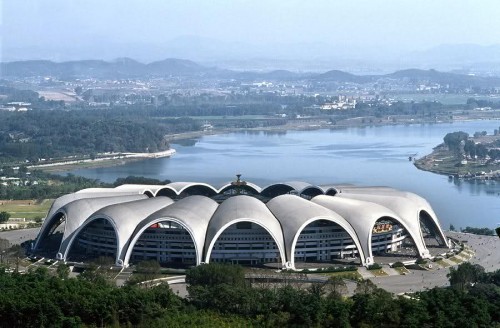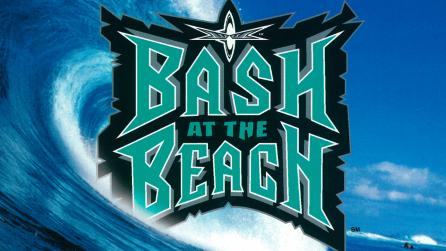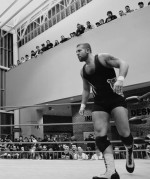Lucky Thirteen #5
Hallowed Halls of Headlocks
Written by Mark Adam Haggerty
Do you remember the first wrestling match you ever went to? How about the first event you ever saw live on TV? Can you recall where it was? WCW and New Japan set the all-time attendance record for professional wrestling in 1995 when they attracted over 300 thousand people to the Mayday Stadium in Pyongyang, North Korea over the course of a two day event. Wrestlemania XXXII will take place inside the state-of-the-art AT&T Stadium in 2016; regardless of whether the WWE's attendance record is 93,173 or 80,335—the show in Arlington is without question set to surpass all previous box office numbers by ten-to-twenty thousand tickets. With all this talk of extravagant events and sold-out stadiums, it's easy to overlook some of the more humble places where sports entertainers have �laid their cap.' An arena doesn't need a retractable roof to host a five-star match when any old armory or bingo hall will do the trick. You've heard of Top Ten Lists before, well this is the "Lucky Thirteen"—this week we're counting down the Top Thirteen Venues in Wrestling or what I'd like to call "Hallowed Halls of Headlocks."
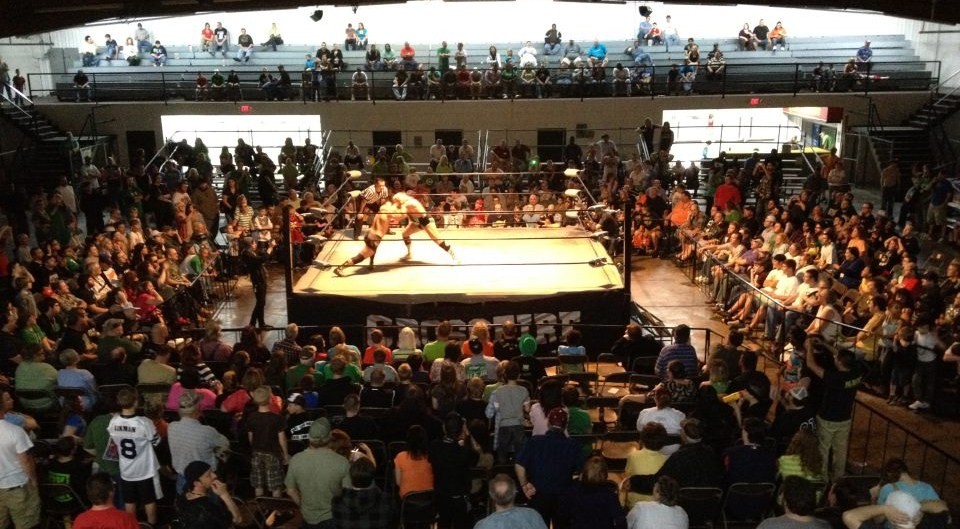
13. Tennessee State Fairgrounds
Highest Claimed Attendance – 1,300 on May 5, 2003 by NWA TNA
The first location on our list can still be found in Nashville, Tennessee—in fact, the Tennessee State Fairground Sports Arena has been the home to every episode of Ring of Honor TV since the beginning of 2015. The makeshift community center was built in 1922 by a band of carpetbaggers sent down from South Dakota, and served as a flea market until professional wrestler Nick Gulas took over in the 1960's. Gulas would go on to promote his own events in the arena throughout the �60s and �70s; the building would later be referred to as the "Nick Gulas Sports Arena." In 2002 the National Wrestling Alliance sought to salvage their reputation by running a series of weekly pay-per-view events under the name "Total Nonstop Action." TNA began in Alabama but by week six moved operations to the Tennessee State Fairgrounds, a little-known wrestling arena that would soon be known to the world as the "TNA Asylum." TNA ran 95 of its 110 weekly pay-per-views from the Asylum until moving once more down to Orlando, Florida. Since losing its longtime tenant, the �Fairgrounds have continued to host a litany of exciting wrestling events, including the first televised Ring of Honor pay-per-view, "The Best in the World" on June 22, 2014.
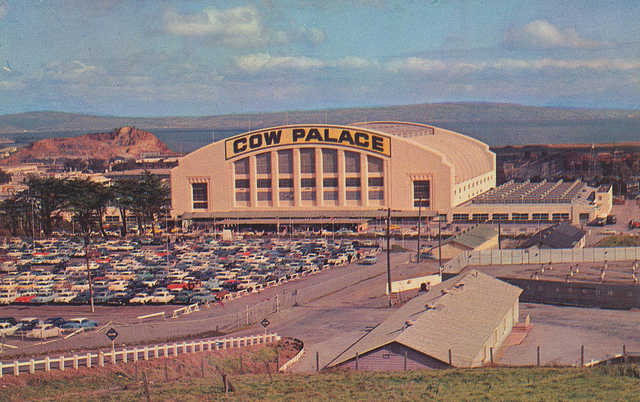
12. San Francisco Cow Palace
Highest Claimed Attendance – 14,600 on November 15, 1988 by WWE
The Cow Palace has been a staple in American athletics since it was originally opened in 1941. Located in Daly City, California—just on the border of San Francisco, this multi-purpose sports facility has hosted the NHL's San Jose Sharks, the NBA's San Francisco Warriors, and an array of minor league teams. The Cow Palace has a storied history when it comes to hosting bull riding competitions. In fact the name "Cow Palace" comes from a joke made by a local radio personality, angry with the money being spent on the local cattle industry during the depths of the Depression: "Why, when people are starving, should money be spent on a palace for cows?" The Cow Palace has been an iconic epicenter for professional wrestling in the Pacific Northwest ever since. Talents from California up through Portland and into Seattle worked the Cow Palace, as did members of the NWA, Vince McMahon's WWF and Verne Gagne's AWA. The �Palace was famous for hosting legendary superstars such as Pat Patterson, Ray Stevenson, Roddy Piper, and the Wild Samoans. The most famous Cow Palace moments in modern wrestling history included three WCW Superbrawl events (1997, 1998, and 2000) as well as WWE No Way Out 2004.

11. Pontiac Silverdome
Highest Claimed Attendance – 93,173 on March 29, 1987 by WWE
The largest venue on our countdown also happens to have hosted the fewest wrestling events as well. The Pontiac Silverdome, located just a stone's throw from Detroit, Michigan served as the stage for one of the biggest events in sports history—Wrestlemania III. Although the WWE's reported figure of 93,173 is considered erroneous, the event was undoubtedly the largest wrestling event up until that time. The Silverdome began as a dream and came to fruition as a college project. The facility was opened in 1975 and served to host several different events including John Paul II's visit in September 1987 which achieved a legitimate audience of 93,682. The Detroit Pistons called Pontiac home for ten years until 1988, and the Detroit Lions played on the field until 2001. The stadium was closed in 2006, and then reopened in 2010. In 2012, the Pontiac Silverdome once again made attendance history when the NBA All-Star Game garnered 108,713 basketball fans. In 2014, the owners of the Silverdome announced that all of the contents within the building would be sold at auction including the fixtures and seats.

10. Arena Mexico
Highest Claimed Attendance – 16,500 maximum capacity reported by CMLL
The largest facility specifically designed for professional wrestling is located in Mexico City and seats over 16,000 Lucha Libre fanatics. Construction began in the 1950's when CMLL owner Salvador Lutteroth decided to build his own wrestling arena. After spending years developing what would become one of the largest sports complexes in Mexico, the venue was finished in 1956. Since opening, Arena Mexico has played host to thousands of CMLL events including weekly shows, television tapings and pay-per-views. In 1968 the Arena was chosen by the Olympic Committee to house the Summer Games' boxing competition. The interior of Arena Mexico is painted with an assortment of colors including those of the Mexican flag, and the letters CMLL stand prominent over the ring at all times. While it might not be the only brand-specific arena in the world, it is most certainly the biggest as it dwarfs TNA's Impact! Zone as well as the WWE Performance Center at Full Sail University.

9. The Omni Coliseum
Highest Claimed Attendance – 13,693 on May 3, 1997 by WCW
One of the most synonymous sounds with both Georgia Championship Wrestling and WCW has got to be "Omni." Whenever Ric Flair was hyping an upcoming altercation down in Atlanta odds are he'd mention the infamous Omni Coliseum. The arena was first constructed in the early 1970s with a plan in mind to withstand the tests of time. The roof was designed to purposefully rust so that a permanent protective cover would later form—uh, what? Needless to say this �redneck science' didn't work as city planners failed to take Georgia's humidity and precipitation index into account. The complex opened in 1972 where in its heyday, the Omni was home to both the Atlanta Hawks basketball team, as well as the NHL's Atlanta Flames. By the early 1990s however, holes began to form in the rusted-out roof and along the exterior walls, turning this once gargantuan spectacle into an enormous eyesore. The Omni hosted wrestling classics from the day it opened until weeks before its demolition; the attendance record was set on May 3, 1997 by WCW Nitro just two months before the Omni was destroyed.

8. The Manhattan Center
Highest Claimed Attendance – 1,100 on January 9, 2015 by TNA (Grand Ballroom) &
2,600 on December 3, 2000 by ECW (Hammerstein Ballroom)
The Manhattan Center is the oldest building on our countdown and features not one, but two highly revered performance venues—the Grand Ballroom and the Hammerstein Ballroom. The latter is named for Oscar Hammerstein, who in 1908 opened what was then known as the "Manhattan Opera House." Located at 311 West 34th Street, the building features a state-of-the-art recording studio and has hosted countless musicians from a myriad of different backgrounds across several generations. The Manhattan Center currently belongs to the Unification Church, who in 1976 bought the building for just $3M. The Manhattan Center began its foray into the wild world of wrestling by hosting Monday Night Raw a staggering 28 times, including the debut episode on January 11, 1993. The �Center has also been known to get Extreme as ECW set the wrestling attendance record for the Hammerstein Ballroom in 1999. Similarly TNA broke the Grand Ballroom record just a month ago when they ran their January 9, 2015 TV tapings for Destination America.
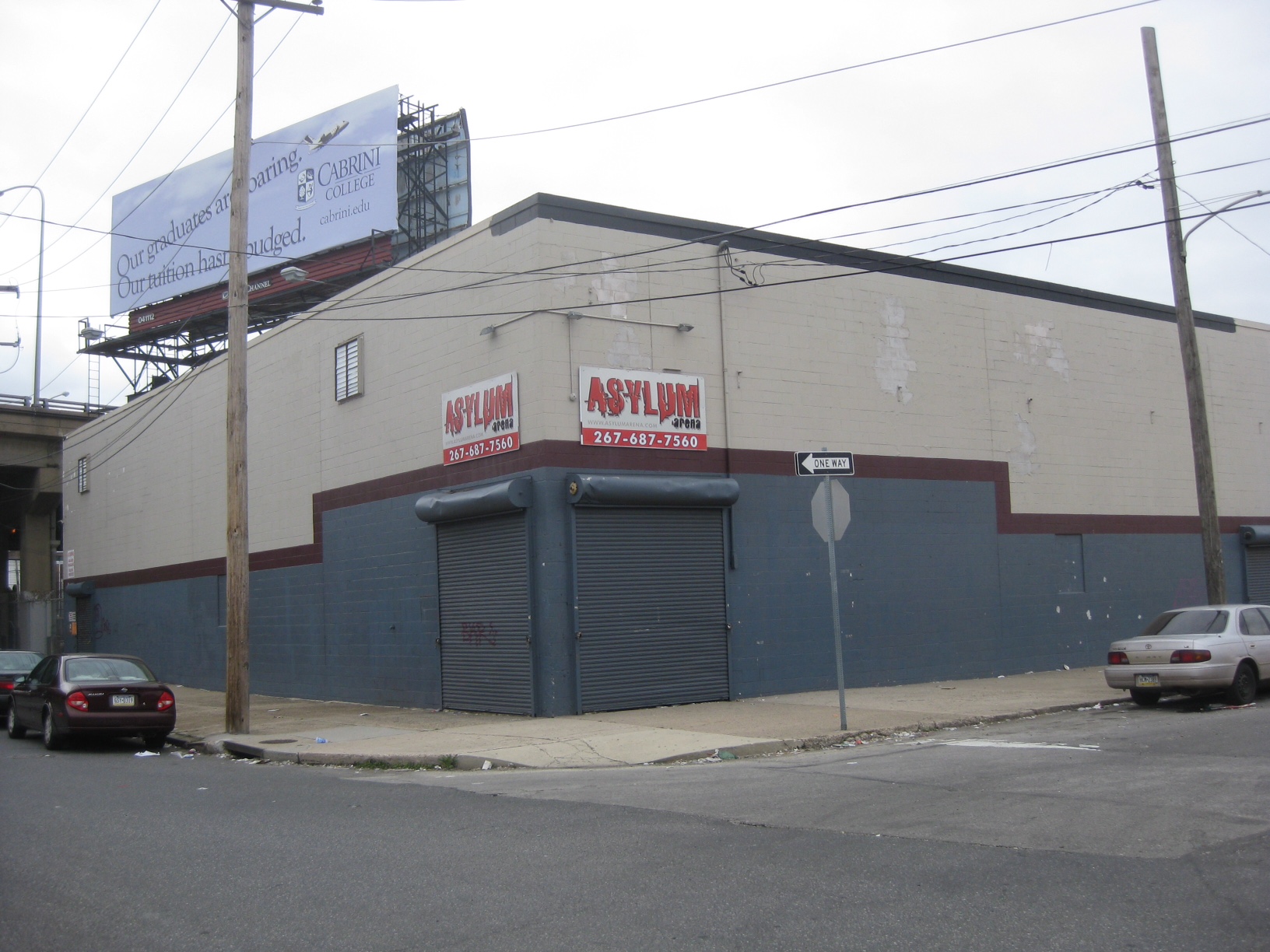
7. The 2300 Arena
Highest Claimed Attendance – 1,700 on January 16, 1999 by ECW
The 2300 Arena is the most recent name given to a factory warehouse in Philadelphia, formerly known worldwide as the ECW Arena. The story behind the most inauspicious wrestling facility on our countdown begins back in the 1970s when the building was used as storage for local warehouses. Within a matter of years, 2300 South Swanson Street was up for sale and soon purchased by law partners Stein & Silverman. They rented the empty space to the local Viking Club who used it as a midnight bingo hall until 1993. At which point, the empty space was alternately configured and repurposed for a third-party wrestling promotion known simply as ECW. Extreme Championship Wrestling called 2300 home from '93 until the promotion folded in 2001, using the building to run events, produce television, and house merchandise. Since then the facility has been used by almost every American wrestling promotion including TNA, ROH, WWE, Chikara, EVOLVE, XPW, as well as international companies such as Dragon Gate, wXw, and New Japan Pro Wrestling. In 2013 the once-grungy auditorium was exponentially upgraded in terms of production, including an increase in seating potential to 2300.
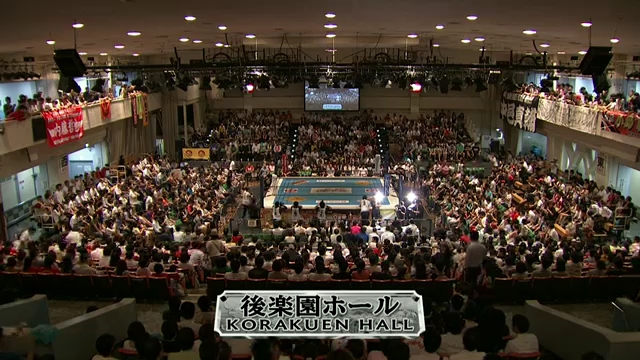
6. Korakuen Hall
Highest Claimed Attendance – 3,000 on November 28, 1980 by AJPW
Much the same as the ECW Arena, this sports entertainment staple has hosted nearly every conceivable wrestling promotion in Japan, as well as a variety of American companies. But Korakuen Hall is no South Philly warehouse, and it is considered by many to be the "Madison Square Garden of Puroresu." Korakuen Hall opened in 1962 and has been a cultural mecca for Japanese wrestling fans ever since, hosting some of the most highly regarded bouts from New Japan, All Japan, NOAH, HUSTLE, and dozens more. Korakuen Hall is located in "Tokyo Dome City," a tourist destination built atop a decommissioned Japanese military arsenal dating back to World War I. The �City' also features an amusement park as well as the legendary Tokyo Dome, itself. In 2014 TNA made history when they chose to run their top event of the year at Korakuen Hall, crossing the Pacific for a pay-per-view for the very first time. In 2008 a second wrestling venue was opened in Tokyo Dome City dubbed "Korakuen 2," however it failed to reach the legendary status of the original. Like Arena Mexico, Korakuen Hall was chosen to display Olympic boxing matches, and continues to host various combat sports including mixed martial arts to this day.
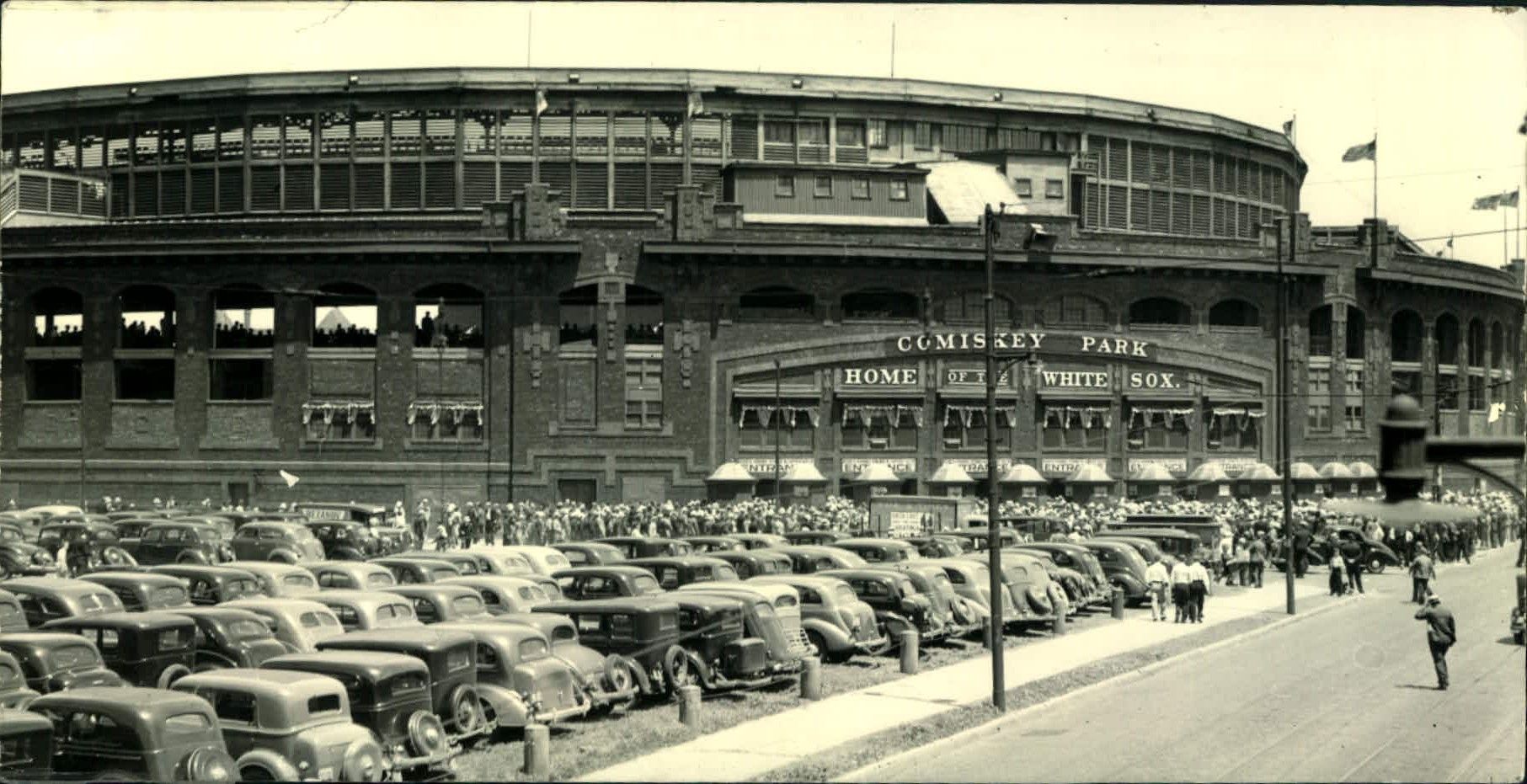
5. Comiskey Park
Highest Claimed Attendance – 30,000 on August 14, 1970 by AWA
Although it's not the oldest venue on the countdown, Comiskey Park was at one time the oldest Major League ballpark in the United States. There was a time when wrestling, boxing, and horse racing were the only three sports Americans were keen to watch. That is until baseball swept the nation and became the undisputed pastime, leading to the construction of such colossal facilities as Chicago's Comiskey Park. Known to many as "White Sox Park," the building was home to the Chicago baseball franchise an astonishing 80 years until the park was closed in 1990. Though it was clearly intended as a baseball diamond, Comiskey Park had its share of high profile wrestling interactions over the years including numerous AWA events from the 1970s and �80s. Verne Gagne set the attendance record in 1970 when he defended his AWA World Heavyweight Championship against Baron Von Raschke, and made history again in 1985 when he partnered with the NWA and WCCW for the first "Clash of the Champions." But the biggest thing to happen inside a wrestling ring at Comiskey Park was just one year after the doors opened, when in 1911 an American by the name of Frank Gotch defeated the European-born George Hackenschmidt for the World Heavyweight Championship.
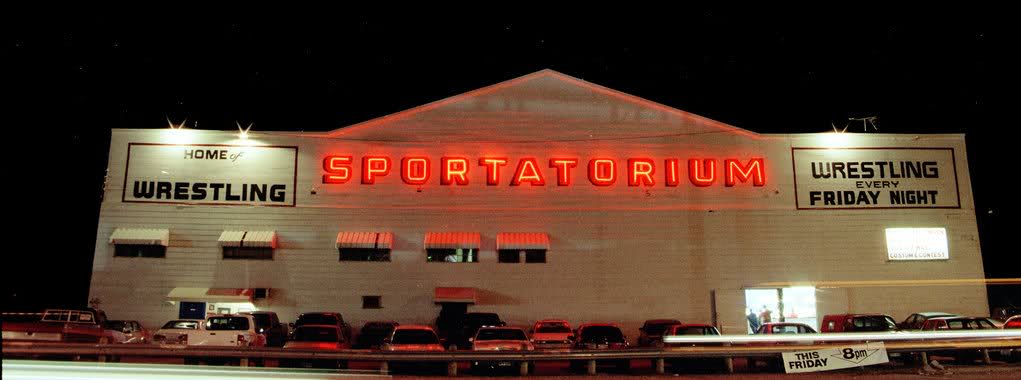
4. The Dallas Sportatorium
Highest Claimed Attendance – 4,000 on January 2, 1988 by WCWA
The Dallas Sportatorium is unmistakably the most disgusting excuse for a wrestling venue this side of the Mississippi River. Back east, I suppose that distinction might go to the ECW Arena. The Sportatorium was a derelict airplane hanger-sized facility located at 1000 South Industrial Boulevard in Dallas Texas. Built in 1935, the structure was never in pristine condition and suffered greatly from ventilation problems, especially during the hot Texas summers. The Sportatorium was notorious for its rodent infestation, as well as structural damage that made for large holes in the middle of the floor. Despite all of its flaws, the Dallas Sportatorium was still sacred and passed through many hands from the day it opened until its destruction in 2003. A total of ten owners laid claim to the Sportatorium, including Big Time Wrestling, the NWA, the Global Wrestling Federation, and of course World Class Championship Wrestling. WCCW and the Von Erich's put both the Sportatorium and Texas wrestling on the map in terms of exciting entertainment. After the tragedies surrounding Fritz and his family began to mount, other promoters tried their hand at finding the same success, but failed miserably. In 2001 a fire ripped through the 70-year old frame of the building, rendering the already-dilapidated complex uninhabitable. The Sportatorium was officially demolished in 2003.

3. Greensboro Coliseum
Highest Claimed Attendance – 21,427 on April 26, 1998 by WWE
While it's easy enough to establish a home base for the WWE, ECW, even TNA—where was the WCW's "Madison Square Garden?" The Greensboro Coliseum is located deep in the heart of Flair Country, right in the hotbed of what was once Jim Crockett Promotions' territory. The �Coliseum hosted an unfathomable number of NWA and WCW events over the years including the first four Starrcade events. The Carolinas have always been Basketball country, and the Greensboro Coliseum has a long history as host to both NBA and college teams; the �Coliseum is currently home to the University of North Carolina at Greensboro "Spartans" men's basketball team. The venue was opened in 1959 and has since undergone an array of renovations including massive additions in 1972, 1993, 2003, and most recently in 2011. Although hosting a plethora of NWA and WCW action over the years, it was the WWE who in 1998 set the wrestling attendance record for the Greensboro Coliseum with the very first Unforgiven pay-per-view.

2. The Tokyo DomeВ
Highest Claimed Attendance – 70,000 on April 4, 1998 by NJPW
The largest sports complex in Tokyo, Japan opened in 1988; nicknamed the "Big Egg," the Tokyo Dome is the focal point of the Tokyo Dome City tourist destination. The �Dome has hosted several musical performances from both Japanese and internationally renowned talents including Britney Spears and Guns N' Roses. But the Big Egg is perhaps best known as the home field to the Yomiuri Giants—the local baseball franchise. Known outside of Japan as the "Tokyo Giants," the team is owned by the Yomiuri media conglomerate and are comparable in popularity to the New York Yankees. In fact the Yankees have even played inside the Tokyo Dome, as have a number of other MLB, NBA, and NFL teams. The Tokyo Dome has hosted puroresu action since it opened, including the annual January 4th NJPW show that was most recently broadcast to a worldwide audience for the very first time. The �Dome hosted a variety of WCW/NJPW events in the 1990s that would go on to be marketed under the Starrcade banner. The vast size of the Tokyo Dome makes it a preferred venue for performers of all kinds; NJPW attendance inside the Dome has ranged from 16,000 to 60,000 at any given time, with the record set in 1998 with 70,000 people on hand for the "Inoki Finals."
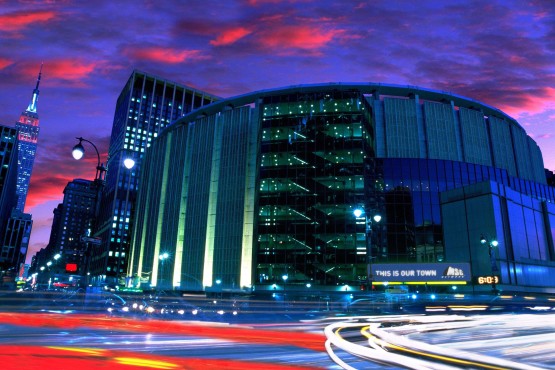
1. Madison Square Garden
Highest Claimed Attendance – 22,292 on January 23, 1984 by WWE
It should come as no shock that the number one venue for professional wrestling is the "House that Bruno built." After comparing no fewer than three other locations to MSG over the course of this countdown, you've probably been waiting for it to make an appearance. But believe it or not, the modern-day coliseum that sits atop Penn Plaza is the fourth in the evolutionary lifespan of Madison Square Garden. The first was opened in 1879 near the actual Madison Square, but lasted only 11 years as it lacked any sort of coverage—an impractical design for a city dipping below zero during the winter. The second was also near Madison Square and existed an astonishing 35 years until it was deemed a financial failure in 1925. The third Madison Square Garden lasted from 1925 until 1968 on 8th Avenue between 49th and 50th Street. The current MSG was built over the old Penn Station Railway tracks where it remains to this very day. It was the fourth and final Madison Square Garden that housed wrestling icons such as Bruno Sammartino, Superstar Billy Graham, Roddy Piper, and hundreds more. In 1984 Vince McMahon and Terry Bollea introduced the world to Hulkamania—a multifaceted phenomenon that continues to run wild in 2015. Madison Square Garden was the home base for the WWF during its meteoric rise to the top of professional wrestling, hosting blood-thirsty bouts like the battle between Sgt. Slaughter and Pat Patterson, as well as entertainment masterpieces such as the "War to Settle the Score." Madison Square Garden was the location of the very first Wrestlemania in 1985 in addition to the tenth and twentieth installments of the event in 1994 and 2004. The history of World Wrestling Entertainment directly relates to the success of Madison Square Garden as is clearly demonstrated by the WWE-inspired decorations that continue to adorn MSG throughout the year.
Thank you for joining me on another whimsical walk down memory lane. Although some of the sanctified structures we've come to admire have been demolished, many of the most iconic "temples" in professional wrestling still stand tall including each of the Top Three Venues. Who's to say that Korakuen Hall won't one day go the way of the Sportatorium or that Madison Square Garden won't move three more times over the next hundred years? All we can do is enjoy them while they still exist. Perhaps twenty years from now we'll speak of the Impact Zone or WWE Performance Center with the same veneration that we use to talk about the Greensboro Coliseum. Until next time, my name is Mark Adam Haggerty asking why stop at Top Ten when you could instead count down the "Lucky Thirteen?"

